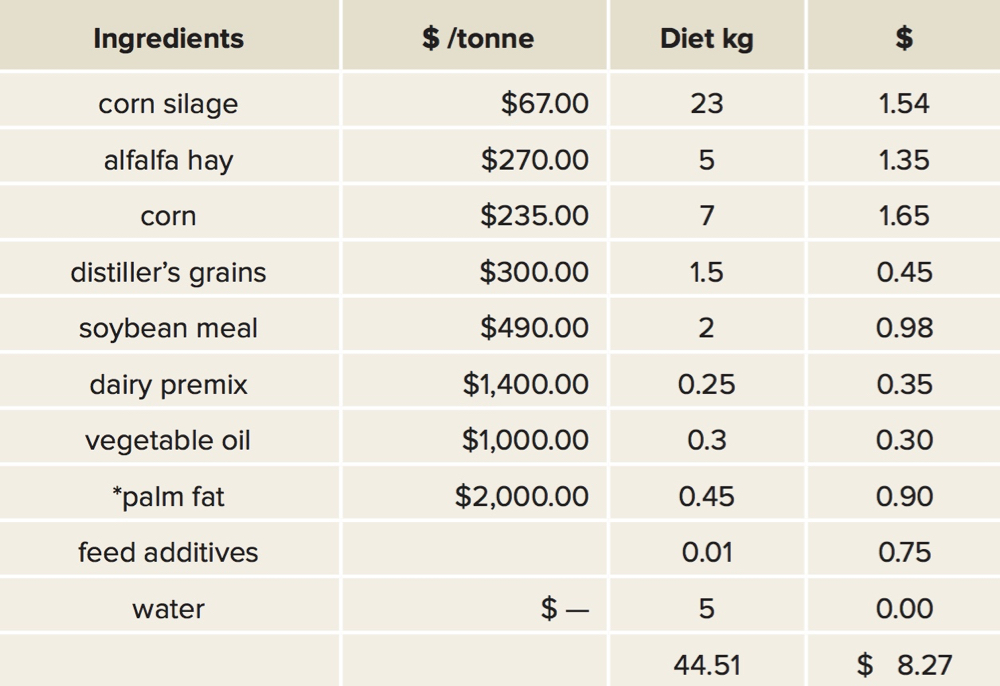
As a dairy nutritionist, I pencil out cost-effective diets for high-producing dairy cows. It’s a matter of matching their nutrient requirements, which support vital functions, general and rumen health, and lactation performance. In the latter, I target early- to mid-lactation dairy cows (60-150 DIM) that are producing 39 kg milk production, four per cent milkfat and 3.3 per cent protein.
My lactation diets are also designed to promote good dry matter intake among dairy cows. I do this by laying a foundation of high-quality forages supplemented with palatable grains and grain byproducts. A complementary dairy premix is added containing essential macro-minerals as well as important trace minerals and fat-soluble A, D and E vitamins. Limit-fed bypass fat and dietary feed additives are also formulated in the final dairy diets.
In this illustrated case, it costs $8.27 of a well-balanced diet to feed a lactating dairy cow. This is a common way to express feed costs, yet there are other ways. For example, $5.30 per kg of milkfat, $9.66 per cwt of milk produced or $0.36 per kg of dairy diet consumed.
Regardless, all of the above costs of feeding a cow are gross numbers. So far, I didn’t account for storage and mixing losses as well as feed refusal by cows. I conservatively estimate these numbers at 10 per cent and two per cent respectively. So, our raw feed cost of $8.27 per cow might be closer to $9.38 per cow, despite some salvageable value of feed refusal, which is frequently fed to dairy non-lactating livestock.
In a similar way, my dairy producers rarely discuss yardage, which I define as the daily operating costs of using equipment, labour and fuel to feed the cow herd. I estimate that these direct non-feed costs in a free-stall barn are at least $1 per head per day (you may use your own operation costs). This could elevate our new dairy diet cost to $10-$11 per cow.
Cost-saving measures
With the mild grocery shock of $11 per lactating animal, many dairy producers wonder where they might have saved on feed costs without sacrificing milk and milkfat production. Here are some proven cost-saving measures:
- Feed high-quality forages. Good silage, haylage and hay reduce the use of grain and other feed supplementation, the latter which is likely purchased off-farm and likely more expensive relative to high-quality forages.
- Review the lactation diet. Substitute more expensive ingredients with less costly ones. Palm fat often comprises 10 per cent of the total feed costs. It might be possible to partially substitute it with more cost-effective forage fibre without decreasing milkfat yield.
- Analyze forages and grains. These feed tests match dietary nutrition with the nutrient requirements of high-producing lactation cows. It also helps avoid feeding excessive nutrients. Test moisture of silages and their final TMR diet weekly.
- Budget feed additives. I budget between $0.50 and $0.75 per head per day for feed additives. I often feed a commercial yeast and direct-fed microbial product at 10 g per head daily, which I believe promotes feed efficiency and dry matter intake.
- Good feed management. A TMR that is pushed up to free-stall cows throughout the day, promotes good dry matter intake, more milk production and less feed refusal. Improving mixing and unloading procedures also significantly reduces feed wastage.
Implementing these cost-cutting measures along with the accompanying spreadsheet of feeding costs should help most producers achieve their best cost-effective dairy cow diets.
Source: grainews.ca














